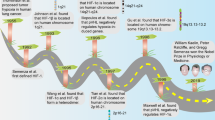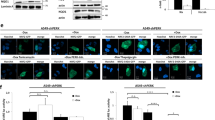Abstract
New therapy targeting the hypoxic fraction of tumors needs to be designed as this population of cells is the most resistant to radio- and chemotherapies. Hypoxia-inducible factor (HIF) mediates transcriptional responses to hypoxia by binding to hypoxia-responsive elements (HRE) in target genes. We developed a hypoxia/HIF-dependent replicative adenovirus (HYPR-Ad) to target hypoxic cells. HYPR-Ad displays hypoxia-dependent E1A expression and conditional cytolysis of hypoxic but not normoxic cells. This work provides proof-of-principle evidence that an attenuated oncolytic adenovirus that selectively lyses cells under hypoxia can be generated. This therapeutic approach can be used to treat all solid tumors that develop hypoxia, regardless of their tissue origin or genetic alterations.
This is a preview of subscription content, access via your institution
Access options
Subscribe to this journal
Receive 50 print issues and online access
$259.00 per year
only $5.18 per issue
Buy this article
- Purchase on Springer Link
- Instant access to full article PDF
Prices may be subject to local taxes which are calculated during checkout




Similar content being viewed by others
Abbreviations
- HIF-1:
-
hypoxia-inducible factor-1
- HRE:
-
hypoxia-responsive elements
- HYPR-Ad#1:
-
hypoxia/HIF-dependent replicative adenovirus
- CRAd:
-
conditionally replicating Ad
- CPE:
-
cytopathic effect
- MOI:
-
multiplicity of infection
References
Bett AJ, Krougliak V and Graham FL . (1995). Virus Res., 39, 75–82.
Boast K, Binley K, Iqball S, Price T, Spearman H, Kingsman S, Kingsman A and Naylor S . (1999). Hum. Gene Ther., 10, 2197–2208.
Brown JM . (2000). Mol. Med. Today, 6, 157–162.
Dachs GU, Patterson AV, Firth JD, Ratcliffe PJ, Townsend KM, Stratford IJ and Harris AL . (1997). Nat. Med., 3, 515–520.
Dery CV, Herrmann CH and Mathews MB . (1987). Oncogene, 2, 15–23.
Fueyo J, Gomez-Manzano C, Alemany R, Lee PS, McDonnell TJ, Mitlianga P, Shi YX, Levin VA, Yung WK and Kyritsis AP . (2000). Oncogene, 19, 2–12.
Fulci G and Chiocca EA . (2003). Front. Biosci., 8, e346–e360.
Glenn GM and Ricciardi RP . (1988). Virus Res., 9, 73–91.
Graeber TG, Osmanian C, Jacks T, Housman DE, Koch CJ, Lowe SW and Giaccia AJ . (1996). Nature, 379, 88–91.
Griffiths L, Binley K, Iqball S, Kan O, Maxwell P, Ratcliffe P, Lewis C, Harris A, Kingsman S and Naylor S . (2000). Gene Ther., 7, 255–262.
He TC, Zhou S, da Costa LT, Yu J, Kinzler KW and Vogelstein B . (1998). Proc. Natl. Acad. Sci. USA, 95, 2509–2514.
Ishii N, Maier D, Merlo A, Tada M, Sawamura Y, Diserens AC and Van Meir EG . (1999). Brain Pathol., 9, 469–479.
Kirn D . (2001). Gene Ther., 8, 89–98.
Koshikawa N, Takenaga K, Tagawa M and Sakiyama S . (2000). Cancer Res., 60, 2936–2941.
Kruyt FA and Curiel DT . (2002). Hum. Gene Ther., 13, 485–495.
Markert JM, Medlock MD, Rabkin SD, Gillespie GY, Todo T, Hunter WD, Palmer CA, Feigenbaum F, Tornatore C, Tufaro F and Martuza RL . (2000). Gene Ther., 7, 867–874.
Modlich U, Pugh CW and Bicknell R . (2000). Gene Ther., 7, 896–902.
Parks CL, Banerjee S and Spector DJ . (1988). J. Virol., 62, 54–67.
Post DE and Van Meir EG . (2001). Gene Ther., 8, 1801–1807.
Prentice H, Bishopric NH, Hicks MN, Discher DJ, Wu X, Wylie AA and Webster KA . (1997). Cardiovasc. Res., 35, 567–574.
Ruan H, Su H, Hu L, Lamborn KR, Kan YW and Deen DF . (2001). Neoplasia, 3, 255–263.
Ruan H, Wang J, Hu L, Lin CS, Lamborn KR and Deen DF . (1999). Neoplasia, 1, 431–437.
Semenza GL . (2000). Genes Dev., 14, 1983–1991.
Shibata T, Giaccia AJ and Brown JM . (2000). Gene Ther., 7, 493–498.
Talks KL, Turley H, Gatter KC, Maxwell PH, Pugh CW, Ratcliffe PJ and Harris AL . (2000). Am. J. Pathol., 157, 411–421.
Tollefson AE, Hermiston TW and Wold WSM . (1999). Adenovirus Methods and Protocols: Methods in Molecular Medicine. In: Wold WSM. (ed). Humana Press: Totowa, pp 1–9.
Tsukuda K, Wiewrodt R, Molnar-Kimber K, Jovanovic VP and Amin KM . (2002). Cancer Res., 62, 3438–3447.
Zhong H, De Marzo AM, Laughner E, Lim M, Hilton DA, Zagzag D, Buechler P, Isaacs WB, Semenza GL and Simons JW . (1999). Cancer Res., 59, 5830–5835.
Acknowledgements
We thank Drs L Gooding and A Turnell for generously supplying antibodies and technical advice, members of the Van Meir lab for their helpful discussions, and Drs Dan Brat, Chalet Tan, Leland Chung, Chia-Ling Hsieh, and Lily Yang for a critical reading of the manuscript. This research was supported by NIH Grants CA87830 and NS41403, the C Geyer Foundation and The Brain Tumor Society.
Author information
Authors and Affiliations
Corresponding author
Rights and permissions
About this article
Cite this article
Post, D., Van Meir, E. A novel hypoxia-inducible factor (HIF) activated oncolytic adenovirus for cancer therapy. Oncogene 22, 2065–2072 (2003). https://doi.org/10.1038/sj.onc.1206464
Received:
Revised:
Accepted:
Published:
Issue Date:
DOI: https://doi.org/10.1038/sj.onc.1206464
Keywords
This article is cited by
-
Modifying oncolytic virotherapy to overcome the barrier of the hypoxic tumor microenvironment. Where do we stand?
Cancer Cell International (2022)
-
Oncolytic viruses: adenoviruses
Virus Genes (2017)
-
The effects of hypoxia on the stemness properties of human dental pulp stem cells (DPSCs)
Scientific Reports (2016)
-
Potent antitumor activity of Oct4 and hypoxia dual-regulated oncolytic adenovirus against bladder cancer
Gene Therapy (2015)
-
Oncolytic Viruses in the Treatment of Cancer: A Review of Current Strategies
Pathology & Oncology Research (2012)



